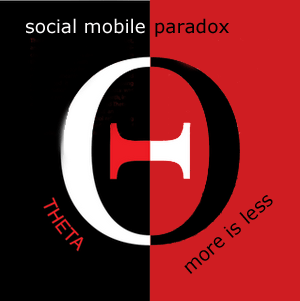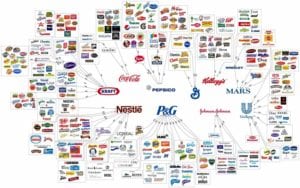How to Leverage the Social Mobile Marketing Paradox


Marketing Paradox
Today’s good news, thanks to social, mobile and content marketing, is every brand, company and personal brand has exponentially more touch points. The bad news is every company, brand and personal brand has exponentially more touch points. Gatekeepers ruled the world. New York Times editors decided what we read. CBS, NBC and ABC programmed what we watched. Schools and colleges decided what we learned.
Visualize a monopoly board with many hotels and houses. Each house and hotel represents a powerful gatekeeper, gatekeepers you needed pay when landing on Boardwalk or Park Place. Now sweep your hand across the board. Houses, hotels and gatekeepers are a mess. How do we pass go and make $200 in such a morass? Gatekeepers meant making money was easier, but most of the money went to an increasingly powerful few as this infographic showing the 10 companies that make almost everything we buy demonstrates (click the graphic to see a larger version):
Distribution Gatekeepers
Distribution power such as P&G, Walmart or Amazon is another form of powerful gatekeeping. Once distribution channels are consolidated and BIG increasing efficiency is how money is made. Big box retailers tweak their “efficiency engine” or distribution logistics to make money. Customers are expressed and managed as Big Data in these systems so somewhat removed from the “front lines”.
P&G, after their Gillette purchase, is so large they were forced to explore outsourcing R&D (read P&G’s New Innovation Model HBR post explaining why the old R&D is gone). Procter & Gamble’s R&D requirements are so great lack of new STUFF could easily become a problem for everything else:
Most companies are still clinging to what we call the invention model, centered on a bricks-and-mortar R&D infrastructure and the idea that their innovation must principally reside within their own four walls. To be sure, these companies are increasingly trying to buttress their laboring R&D departments with acquisitions, alliances, licensing, and selective innovation outsourcing. And they’re launching Skunk Works, improving collaboration between marketing and R&D, tightening go-to-market criteria, and strengthening product portfolio management.
But these are incremental changes, bandages on a broken model. Strong words, perhaps, but consider the facts: Most mature companies have to create organic growth of 4 percent to 6 percent year in, year out. How are they going to do it? For P&G, that’s the equivalent of building a $4 billion business this year alone. Not long ago, when companies were smaller and the world was less competitive, firms could rely on internal R&D to drive that kind of growth. For generations, in fact, P&G created most of its phenomenal growth by innovating from within—building global research facilities and hiring and holding on to the best talent in the world. That worked well when we were a $25 billion company; today, we’re an almost $70 billion company.
By 2000, it was clear to us that our invent-it-ourselves model was not capable of sustaining high levels of top-line growth. The explosion of new technologies was putting ever more pressure on our innovation budgets. Our R&D productivity had leveled off, and our innovation success rate—the percentage of new products that met financial objectives—had stagnated at about 35 percent. Squeezed by nimble competitors, flattening sales, lackluster new launches, and a quarterly earnings miss, we lost more than half our market cap when our stock slid from $118 to $52 a share. Talk about a wake-up call.
The world’s innovation landscape had changed, yet we hadn’t changed our own innovation model since the late 1980s, when we moved from a centralized approach to a globally networked internal model—what Christopher Bartlett and Sumantra Ghoshal call the transnational model in Managing Across Borders.
Efficiency’s Irony
The irony of highly efficient systems is as they approach some number (T) they wobble and become less efficient. Let’s call the number where at least a $1.something to $1 return exists a “Theta”. Theta is the last perfect balance before efficiency erodes and $1 in produces less than $1 back. When P&G squeezed marketing and distribution they crushed R&D. As P&G approached their Theta a wobble knocked systems over like sweeping the monopoly board in our opening analogy.
Efficiency is a balancing act. Knowing how to tighten bolts in one area and loosen in another is a CSF (Critical Success Factor). There is no system that can ONLY increase in efficiency due to Efficiency’s Irony:
Efficiency’s Irony
As an efficient system approaches Theta a wobble lowers return and creates inefficiency.
Mind Shift
Efficiency’s Irony means creating organizational change as P&G did, with some pain, is a must:
We knew that most of P&G’s best innovations had come from connecting ideas across internal businesses. And after studying the performance of a small number of products we’d acquired beyond our own labs, we knew that external connections could produce highly profitable innovations, too. Betting that these connections were the key to future growth, Lafley made it our goal to acquire 50 percent of our innovations outside the company. The strategy wasn’t to replace the capabilities of our 7,500 researchers and support staff, but to better leverage them. Half of our new products, Lafley said, would come from our own labs, and half would come through them.
It was, and still is, a radical idea. As we studied outside sources of innovation, we estimated that for every P&G researcher there were 200 scientists or engineers elsewhere in the world who were just as good—a total of perhaps 1.5 million people whose talents we could potentially use. But tapping (crowdsourcing) into the creative thinking of inventors and others on the outside would require massive operational changes. We needed to move the company’s attitude from resistance to innovations “not invented here” to enthusiasm for those “proudly found elsewhere.” And we needed to change how we defined, and perceived, our R&D organization—from 7,500 people inside to 7,500 plus 1.5 million outside, with a permeable boundary between them.
P&G’s New Innovation Model HBR emphasis mine.
During our training in Cincinnati, when I worked for P&G in 1981, I could see and feel how proud the company is of their R&D. Shifting P&G’s culture to a, “50% not created here” environment is a massive paradigm shift. Efficiency’s irony is one reason for the urgency of P&G’s shift, the Internet is the other.
Social Mobile Rocket Fuel
Without rocket fuel poured on P&G’s R&D fire from logistics and marketing the “invented here” culture may exist still. When two major engines approach THETA watch out. Marketing and distribution were approaching Theta in P&G’s case especially after the Gillette purchase.
The good news is most highly efficient systems know some of their Thetas. Think of Thetas as Key Performance Indicators or KPIs. Walmart knows to ship Pop-Tarts to Florida when the weather turns. No one asks WHY. The question is moot. They take that action because their Big Data tells them too.
The social mobile web brings new factors to Efficiency’s Irony including:
- Real Time BIG DATA.
- Social media and a more immediate and intimate connection with customers.
- User Generated Content’s (UGC’s) shorter (in time), richer (in substance) feedback loops.
P&G’s new system for innovation describe by the Harvard Business Review (HBR) used these factors (and web tools) to value and incorporate innovation from smaller companies worldwide. P&G now shares treasures previously unimaginable. When I visited P&G in 1981 there were black curtains hiding mock grocery shelves at P&G’s headquarters least “secrets” get out. One of the important implications of global, real time, BIG DATA is the death of secrets.
When P&G asked the question, “Can anyone help,” they found more than a million R&D scientist “at least as capable as ours”. One way to overcome “Efficiency’s Irony” is to use the same web tools creating the irony in the first place (and yes that too is ironic). We may find the greatest return from social and mobile marketing comes from intranets, “within company” or “within supply chain” applications.
The real social mobile marketing paradox is we don’t know what we don’t know.
Tools that currently feel like B2C company to consumer connection apps are undeniably powerful and their impact on Efficiency’s Irony and other logistics, distribution and marketing problems so new no “best practices” exist. How this paradox unfolds will determine the Facebook, Google and Twitter of a new generation of innovators able to mesh powerful scaled systems together to create, distribute, publish and monetize our social mobile marketing paradox.
Latest posts by Martin (Marty) Smith (see all)
- The New Ecommerce: Current Best Practices - August 18, 2014
- Can Subscriptions Smite The SEO Giant? - August 11, 2014
- Invisible Giant: Why Its Hard To See the New SEO - August 4, 2014


